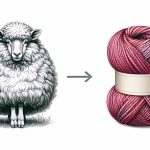Wool is definitely a natural product. It comes from sheep's fleece, well-known for its exceptional qualities and eco-friendliness. Its unique structure is great for insulation and resilience. Water repellence and biodegradability are its notable features. If you want to discover more about wool, keep exploring its fascinating characteristics and historical importance.
Table of Contents
Key Takeaways
- Wool is a natural product derived from sheep's fleece.
- It is not artificially created or synthesized.
- Wool fibers are organic and biodegradable.
- Wool's properties are inherent and not man-made.
- Wool is a sustainable and eco-friendly material.
Definition of Wool
Wool, a natural fiber sourced from the fleece of sheep, is known for its unique properties and versatility in various applications. Wool fibers are strands of keratin, a protein found in sheep's fleece, making them strong and resilient. These fibers have a natural crimp, giving wool its characteristic bounce and elasticity. Due to this crimp, wool fibers trap pockets of air, providing excellent insulation that helps retain body heat in cold weather.
When looking at wool fibers under a microscope, you can see the overlapping scales that make wool naturally water repellent. This quality helps protect sheep from the elements and also makes wool garments resistant to moisture. Additionally, wool fibers are biodegradable, meaning they can naturally decompose without causing harm to the environment. Unlike synthetic fibers, wool is a sustainable choice due to its renewable nature, as sheep produce new fleece annually. Wool fibers truly stand out for their combination of strength, insulation, water resistance, and eco-friendly characteristics.
Wool Properties
With its exceptional moisture absorption and thermal regulation, wool exhibits unique properties that set it apart from other fibers. Wool's natural crimp gives it elasticity and resilience, making it a versatile material for various applications. Here are some key properties of wool:
- Moisture Absorption: Wool can absorb up to 30% of its weight in moisture without feeling damp, keeping the wearer dry and comfortable.
- Breathability: Wool's structure allows air to circulate, preventing overheating and ensuring comfort in various climates.
- Heat Retention: The natural crimp of wool fibers creates insulating air spaces, trapping heat and providing warmth in cold conditions.
- Flame Resistance: Wool is inherently flame-resistant, making it a safe choice for clothing, bedding, and upholstery.
- Biodegradability: Wool is biodegradable and sustainable, reducing environmental impact and making it an eco-friendly option.
These properties make wool a preferred choice for high-quality garments, bedding, and home textiles, showcasing its unique combination of comfort, durability, and sustainability.
Production Process
In the production process of wool, sheep fleece is sheared, cleaned, carded, spun, and woven to create the final product.
Shearing is the initial step, where the fleece is carefully removed from the sheep. Once collected, the fleece undergoes cleaning to remove impurities like dirt and grease. Carding follows, aligning the fibers to prepare them for spinning.
Spinning then twists the fibers together, creating yarn or thread. This yarn is woven into various textiles, from cozy sweaters to durable carpets.
It's crucial to emphasize that wool isn't chemically altered during production, preserving its natural qualities such as warmth, breathability, and moisture-wicking properties. The production of wool combines traditional methods with modern technologies for efficiency without compromising the integrity of the material.
Additionally, as sheep regrow their wool annually, wool is considered a sustainable and renewable resource. This process ensures that high-quality wool is made, ready to be used in a wide range of products.
Wool Classification
I'll now touch on the points related to Wool Classification, which include:
- Wool Fiber Types
- Natural Wool Properties
- Wool Processing Methods
Understanding these aspects is important for categorizing wool based on its characteristics and intended applications in various products.
Wool Fiber Types
During the processing of wool fibers, they're categorized into fleece, broken, bellies, and locks. When it comes to wool fiber types, understanding these classifications is essential for determining the quality and best use of the wool.
Here are some key points to keep in mind:
- Fleece: Consists of the best and highest quality wool from the sheep's back.
- Broken: Wool fibers that are shorter and usually come from the sheep's legs and lower body.
- Bellies: Wool from the sheep's belly area, often of lower quality compared to fleece wool.
- Locks: Long, unshorn wool fibers that can be used for specialty products like hand spinning.
- Merino Wool: Known for its softness and fineness, often used in high-end clothing due to its premium quality.
Natural Wool Properties
Wool fibers exhibit distinct natural properties that enable their classification based on key characteristics such as fleece, broken, bellies, and locks. These natural fibers, primarily sourced from sheep, vary in quality and texture.
The fleece wool, considered the best quality, comes from the sheep's back and sides. Broken wool, on the other hand, is shorter and coarser, often found on the sheep's legs and lower body.
Bellies wool is softer but less durable, originating from the sheep's belly area. Locks wool consists of long, curly fibers used for specialty products.
Understanding these natural properties is essential for determining the right type of wool for specific applications, ensuring excellent performance and quality.
Wool Processing Methods
In wool processing methods, fibers are categorized into different grades based on quality and characteristics to determine their best end use.
- Wool processing involves categorizing wool into fleece, broken, bellies, and locks.
- Raw wool is graded and sorted by diameter and style during wool classification.
- Specific products utilize different grades of wool, with finer grades suitable for garments.
- Coarser grades are used for outerwear or rugs due to their characteristics.
- Scouring, a cleaning process using water, detergent, and alkali, is essential before commercial use.
Historical Significance
The historical significance of wool in trade and economies spans centuries, shaping global markets and influencing key innovations. Wool products have played a crucial role in historical economies, with wool being a significant trade commodity as early as the 13th century. English wool exports were highly prized in the 15th century, even rivaling those of Castile.
Innovations such as the putting-out system and the emergence of banking houses like the Medici in Florence transformed the wool industry, paving the way for modern manufacturing practices. The Industrial Revolution further revolutionized wool manufacturing through mass production techniques, propelling the industry into a new era of efficiency and scale.
British laws have historically wielded significant control over the wool trade, both promoting and regulating its activities, thereby shaping its development and significance on the global stage. Wool's historical journey through trade and innovation has left an indelible mark on economies worldwide.
Global Wool Market
Stepping into the domain of the worldwide wool market reveals a dynamic landscape shaped by key producers and market trends.
- Global wool production stands at around 2 million tonnes annually, playing a significant role in the textile industry.
- Wool constitutes approximately 3% of the global textile market, showcasing its enduring popularity.
- Australia, renowned for its Merino sheep, leads as the top producer of wool fabrics.
- New Zealand, specializing in crossbred wool, secures its place as the third-largest producer globally.
- Major players in the global wool market include China, Australia, New Zealand, Turkey, and the United Kingdom, each contributing uniquely to the industry's tapestry.
The intricate web of global wool production and trade underscores the essential role wool fabrics play in the textile sector. As these key producers continue to drive the market forward, the demand for high-quality wool remains unwavering, sustaining its position as a sought-after material in the domain of textiles.
Wool Textile Industry
I'll now discuss the Wool Textile Industry, covering topics like the Wool Manufacturing Process and Wool Quality Standards.
Understanding how wool is processed and the quality standards involved can help grasp the complexities of the wool textile industry.
This discussion will shed light on the meticulous steps and standards essential in producing high-quality wool textiles.
Wool Manufacturing Process
In wool manufacturing, sheep are sheared to collect raw wool fibers, which then undergo a series of processing steps to create various wool textiles.
- Raw wool fibers are scoured to clean them thoroughly.
- Carding aligns the fibers to prepare them for spinning.
- Spinning twists the fibers into yarns.
- Weaving or knitting converts yarns into fabrics.
- Techniques like felting are used to create dense, non-woven textiles.
The wool manufacturing process involves intricate steps such as cleaning, aligning, twisting fibers, and weaving or knitting to produce a wide range of products like clothing, blankets, carpets, and upholstery.
Wool Quality Standards
After detailing the wool manufacturing process, the focus now shifts to the Wool Quality Standards upheld in the wool textile industry by the Woolmark Company. The United States recognizes the importance of quality assurance in wool production.
The Woolmark Company plays a pivotal role in setting global standards for wool textiles, ensuring that products meet stringent criteria for quality and performance. When consumers see the iconic Woolmark logo on a product, they can trust in the high-quality wool used and the adherence to industry standards. This certification not only signifies premium quality but also guarantees excellence in wool textiles.
Sustainable Wool Practices
Sustainable wool practices involve annually regrowing fleece on sheep, ensuring wool remains a renewable resource.
Here are some key points regarding sustainable wool practices:
- Wool is a renewable resource as sheep regrow their fleece each year.
- Wool decomposes naturally in soil, reducing waste to landfills and enriching the earth with nutrients.
- Grazing sheep help minimize the need for additional resources like oil and refineries.
- Wool is recyclable and degrades faster than synthetic fibers, contributing to a more sustainable textile industry.
- Sustainable wool practices endorse eco-friendly farming methods, supporting the longevity of wool as a natural, environmentally friendly material.
Wool in Fashion
I love how versatile wool is in the fashion world. It allows for the creation of a wide range of stylish and sustainable pieces. Its durability and insulating properties make it a go-to choice for long-lasting garments that keep me cozy in colder seasons.
Plus, knowing that it's a natural and biodegradable material adds an extra layer of appeal to wool fashion pieces.
Wools Versatility in Fashion
Wool's flexibility in the domain of fashion allows it to smoothly shift from cozy winter sweaters to sophisticated tailored suits, showcasing its versatility and timeless appeal.
- Wool can be woven into a variety of garments suitable for different seasons.
- Its insulating properties provide warmth without excessive bulk, making it perfect for winter wear.
- Popular in high-end fashion for its luxurious feel, natural drape, and rich color options.
- Breathable and moisture-wicking, wool is versatile for both casual and formal wear.
- Ideal for creating elegant wool suits that exude sophistication and style.
Sustainable Wool Practices
In the domain of fashion, embracing sustainable wool practices underscores a commitment to ethical sourcing and environmental responsibility. Sustainable wool practices involve using wool from ethically raised sheep, focusing on animal welfare, land management, and resource conservation.
Many fashion brands are now adopting these practices to reduce their environmental impact and meet the growing demand from consumers for eco-friendly products. The shift towards sustainable wool production not only benefits the environment but also contributes to a more responsible and ethical industry.
As consumers become more conscious of the impact of their purchasing decisions, the demand for fashion items made from sustainable wool is on the rise, highlighting the importance of integrating sustainable practices into the fashion supply chain.
Wool in Home Decor
Luxuriously soft and versatile, wool finds its place as a staple in home decor for its timeless elegance and durability. Wool, a natural fiber, not only adds warmth but also enhances the aesthetic appeal of any space with its brilliant color choices. Here are some key reasons why wool is a popular choice in home decor:
- Wool items in home decor last longer due to their resilient fibers that bend without breaking.
- Wool is easy to care for, as its fibers keep dust and dander on the surface, maintaining a cleaner environment.
- Wool provides a luxurious and stylish look to any home setting when used in upholstery, bedding, and drapes.
- Wool's natural fibers offer comfort and a cozy ambiance, making it perfect for rugs and throws.
- Wool's versatility allows it to blend seamlessly with various design styles, from traditional to modern, making it a timeless addition to any home decor scheme.
American Wool Councils Role
The American Wool Council, a key entity within the American Sheep Industry Association, actively works to enhance and promote the American wool industry. As a non-profit organization, the council is dedicated to improving the American wool industry by promoting the use of American wool in both domestic and international markets.
One of the council's main focuses is on enhancing the benefits and applications of wool, particularly in comparison to synthetic fibers. By educating and raising awareness about the unique qualities of wool, the council aims to showcase the natural advantages that wool offers over synthetic alternatives.
Through its efforts, the American Wool Council plays an essential role in advocating for the utilization of American wool, emphasizing its sustainability, durability, and versatility. Overall, the council's work is instrumental in ensuring that American wool remains a preferred choice in various industries and applications, standing out among synthetic fibers for its natural and superior qualities.
Frequently Asked Questions
Is Wool a Natural Product?
Yes, wool is indeed a natural product. It's a fiber sourced from sheep fleece, known for its renewability and biodegradability. Composed of keratin, a natural protein, wool is considered sustainable due to its origins in nature.
Is Wool a Natural Resources?
Wool is a natural resource as it is derived from sheep's fleece, which regrows annually. This renewable material is environmentally friendly, biodegradable, and offers unique properties for various products. Its sustainability and versatility make it an ideal choice.
Can Wool Be Made Artificially?
Wool cannot be artificially made; it's a natural fiber from sheep fleece. Synthetic options like polyester lack wool's unique qualities. Shearing sheep produces wool, contrasting with chemical methods for synthetics. Wool's sustainability and biodegradability surpass artificial fibers.
What Type of Product Is Wool?
Wool is a natural product, sourced from sheep's fleece. It contains keratin, a protein, and isn't artificially made. Wool's key features like moisture absorption and breathability are inherent, solidifying its status as a natural fiber.
- How Does Ring Spun Cotton Affect Garment Fit and Shape Retention? - August 13, 2024
- What Are the Challenges in Producing Ring Spun Cotton? - August 13, 2024
- Is Ring Spun Cotton Suitable for Plus-Size Clothing? - August 13, 2024





